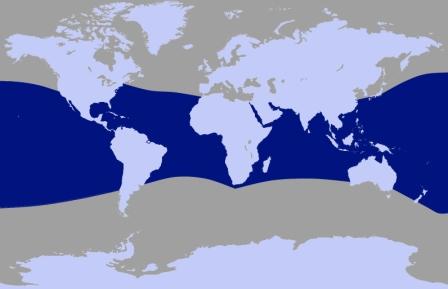
Classification Other Names: Tropical Whale, Eden's Whale, Common Bryde's Whale Suborder: Mysticeti Family: Balenopteridae | Description These animals usually feed alone or in mother-calf pairs. They are sometimes inquisitive and will approach and swim alongside boats. They rarely show more than the top of their heads when surfacing.
|
Bryde's Whale Ecology Range: Tropical and warm temperate waters usually between 40°N and 40°S in waters warmer that 16.3°C. Usual Habitat: Can be found both offshore and inshore. Usual group size: Small groups of 1-7 but can be seen in loose groups of 10 - 30 in areas rich in food. Main Diet: Larger plankton and pelagic schooling fish. Unlike most baleen whales, they do not migrate over large distances and they feed all year long. Local population: Unknown | Global range of the Bryde's Whale  Dark blue areas indicate where Bryde's Whales are likely to be found |
Conservation Information
Protection and Conservation Status
IUCN Conservation Status: Bryde's Whales are listed as "Data Deficient" on the IUCN red list. SPAW Protocol: Bryde's Whales are cetaceans, which are listed under Annex II of the SPAW protocol. As such they require total protection under article 11 of this protocol which prohibits the "taking, possession, killing and commercial trade of the species, their parts or products". The SPAW protocol was created to help with the implementation and promotion of the Ramsar Convention and the Convention on Biological Diversity. The Annexes of the SPAW protocol can be found here. Local Laws: Cetaceans are protected under the Conservation of Wildlife Act of Trinidad and Tobago which offers protection to all species not listed under the second or third schedules of this act. |
Reports of Bryde's Whales in Trinidad and Tobago
This is currently being researched and written. It will appear here shortly.
|
References
The above information was obtained from the following sources:
- A Princeton Field Guide: Whales Dolphins and Other Marine Mammals of the World by Hadoram Shirihai and Brett Jarrett (2006)
- Smithsonian Handbooks: Whales Dolphins and Porpoises by Mark Carwardine and illustrated by Martin Camm (2002)
- The Whale and Dolphin Conservation Society's Species Guide at http://www2.wdcs.org/species/index.php
- The IUCN Redlist at http://www.iucnredlist.org
- The SPAW protocol Annexes with links available at http://www.car-spaw-rac.org/?Annexes-of-the-SPAW-Protocol,83
Acknowledgements
We would like to thank the following people for the use of the art work and photographs:
- Alësha Naranjit (Illustration of Bryde's Whale)